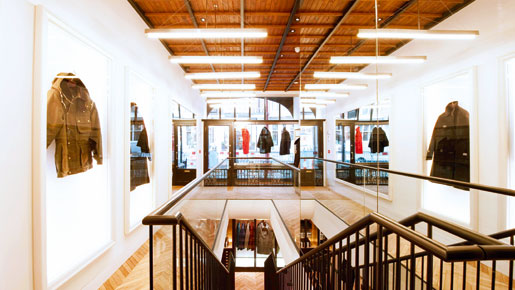
Founded in Glasgow in the 1820s, Mackintosh is not only a well-known brand, it has also come to symbolise an entire product group, namely the wardrobe staple that is the “Mac”. That’s no mean feat in itself, but as far as the brand name goes, it sadly fell by the wayside after suffering a slump in the 1990s. As luck would have it, the glory days were to return. Seeing obvious potential in the raincoat purveyor, esteemed Tokyo firm Yagi Tsusho snapped the brand up in 2007. Armed with new backers, Mackintosh has been successfully reintroduced to the market and positioned back in the uppermost tier.
To increase its association with the highest ranks of fashion, the Glaswegian player opened its first ever standalone store in 2011 on the swanky stretch that is Mount Street in London’s Mayfair. Other supreme contenders that line the same street include Balenciaga, Lanvin and Vivienne Westwood. The interior concept of the Mackintosh store was conceived by Japanese design agency Wonderwall, which pushed an aesthetic best described as an exercise in refined minimalism, punctuated with details such as cloakroom-style coat racks and glass pod display cases.
Heritage translated to the modern day
Looking back to the humble beginnings of Mackintosh, it literally grew from a scrap of waxed cloth to become a household staple with a widespread, loyal clientele. Conceived in 1823 by Glaswegian chemist George Macintosh (who spelled his name without the K that was later added to the brand), Mackintosh began as a type of revolutionary waterproof fabric that outdid any previous materials designed to protect the wearer from rain. A year after the cloth made its first appearance, George Macintosh went about creating coats made from the nifty material he had invented.
The popularity of the garment spread quickly, and became a particular hit among horse riders. The fan base soon expanded, and the coats were adopted by institutions such as the British Army and British Rail. The Mackintosh coat’s uses extended beyond utilitarian means, and it was embraced by the dandies of the 19th-century, who often opted to order their coats in vivid colours and spice up the garment further by adding velvet trims.
Crafted by hand
To keep its heritage alive, the brand continues to produce rubberised coats employing the same procedures used in the 19th Century. Distancing itself from the fast fashion culture and the trend that has seen most fashion manufacturing moved to China and other faraway lands, Mackintosh manufactures its collections in a single factory in Cumbernauld near Glasgow, meaning that all coats come with the elusive label, ‘Made in Britain’. The tailors working for Mackintosh have all undertaken a three-year apprenticeship in the factory, and the care taken to produce each coat is perhaps more important than the design itself.
Almost exclusively made by hand, every coat is created by the same tailor who takes care of every step of the process, from cutting the cloth to adding the finishing touches, such as applying the taped seams. In terms of styles, the brand serves up a wide spectrum of silhouettes for both men and women, with about 300 coats produced every week. As well as selling its wares directly to consumers under the Mackintosh name, the brand has collaborated with some of the fashion industry’s biggest names to produce outerwear that combines both parties’ respective signatures. Some of the fashion houses that rely on Mackintosh’s expertise today are Celine, APC, Junyua Watanabe and Hermes.

